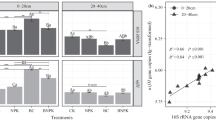Abstract
Background and Aims
The use of wood ash in forestry has been questioned because the cadmium (Cd) concentration of ash, which varies between 1 and 20 mg kg-1 ash, exceeds the level allowed for fertilizers (3 mg kg-1) used in agriculture. To investigate the effects of Cd and ash on the fungal community composition and Cd bioavailability of the humus layer of boreal, coniferous forests, pumice or wood ash, spiked with a water soluble (CdCl2) or insoluble (CdO) form of Cd at three levels (0, 400 and 1000 mg kg-1), were applied at a fertilization level of 5000 kg ha-1 in a laboratory microcosm study.
Methods
After 2 months, the humus in the microcosms was sampled and extracted for total DNA to detect changes in the fungal community by using polymerase chain reaction (PCR) and denaturing gradient gel electrophoresis (DGGE) techniques. PCR was performed using the fungal 18S rDNA primers FR1 + FF390 and FR1 + NS1. The bioavailability of Cd was measured with a bacterial biosensor(Bacillus subtilis BR 151/pT0024) emitting light in the presence of Cd.
Results
Using the primer pairs FR1 + FF390 and FR1 + NS1, resulted in over 35 and 15 DGGE bands, respectively. Both primer pairs detected an ash, but no Cd effect. When using FR1 + FF390, a higher fluorescence was observed in one DGGE band of all ashed samples compared to the pumiced samples. With the primer pair FR1 + NS1, the ashed samples had a DGGE band which was not visible or only faintly visible in the pumiced samples. In addition, one DGGE band disappeared from the ashed samples. Humus layer water extracts showed that the Cd added with the pumice was in a bioavailable form. The luminescence intensity of the biosensor was dependent on the form and level of the Cd added. No luminescence was detected when the Cd was added with the ash.
Conclusions
Ash fertilization altered the humus layer fungal community, whereas the level and form of additional Cd in the ash had no influence because it was not bioavailable.
Similar content being viewed by others
References
Bååth E, Arnebrant K (1993): Microfungi in coniferous forest soils treated with lime or wood ash. Biol Fertil Soils15, 91–95
Fritze H, Bååth E (1993): Microfungal species composition and fungal biomass in coniferous forest soil polluted by alkaline deposition. Microb Ecol25, 83–92
Fritze H, Perkiömäki J, Saarela U, Katainen R, Tikka P, Yrjälä K, Karp M, Haimi J, Romantschuk M, (2000): Effect of Cd-containing wood ash on the microflora of coniferous forest humus. FEMS Microbiol Ecol32, 43–51
Kowalchuk GA, Gerards S, Woldendorp JW (1997): Detection and characterization of fungal infections of Ammophila arenaria (Marran grass) roots by denaturing gradient gel electrophoresis of specifically amplified 18S rDNA. App Env Microbiol63, 3858–3865
Levula T, Saarsalmi A, Rantavaara A, (2000): Effects of ash fertilization and prescribed burning on macronutrient, heavy metal, sulphur and137Cs concentrations in lingonberries(Vaccinium vitis-idaea). For Ecol Manage126, 267–277
Muyzer G, De Waal EC, Uitterlinden AG (1993) Profiling of complex microbial populations by denaturing gradient gel electrophoresis analysis of polymerase chain reaction-amplified genes coding for 16S rRNA. App Env Microbiol59, 695–700
Pennanen T, Paavolainen L, Hantula J (2000): Rapid PCR-based method for the direct analysis of fungal communities in complex environmental samples. Soil Biol Biochem33, 697–699
Smit E, Leeflang P, Glandorf B, van Elsas JD, Wernars K (1999): Analysis of fungal diversity in the wheat rhizosphere by sequencing of cloned PCR-amplified genes encoding 18S rRNA and temperature gradient gel electrophoresis. App Env Microbiol65, 2614–2621
Tauriainen S, Karp M, Chang W, Virta M (1998): Luminescent bacterial sensor for cadmium and lead. Biosens Bioelectr13, 931–938
Vainio EJ, Hantula J, (2000) Direct analysis of wood-inhabiting fungi using denaturing gradient gel electrophoresis of amplified ribosomal DNA. Mycol Res104, 927–936
Young F E, Smith C, Reilly BE (1969): Chromosomal location of genes regulating resistance to bacteriophage inBacillus subtilis. J Bact98, 1087–1097
Author information
Authors and Affiliations
Corresponding author
Rights and permissions
About this article
Cite this article
Fritze, H., Perkiömäki, j., Petänen, T. et al. A microcosmos study on the effects of cd-containing wood ash on the coniferous humus fungal community and the cd bioavailability. J Soils & Sediments 1, 146–150 (2001). https://doi.org/10.1007/BF02986477
Received:
Accepted:
Issue Date:
DOI: https://doi.org/10.1007/BF02986477




